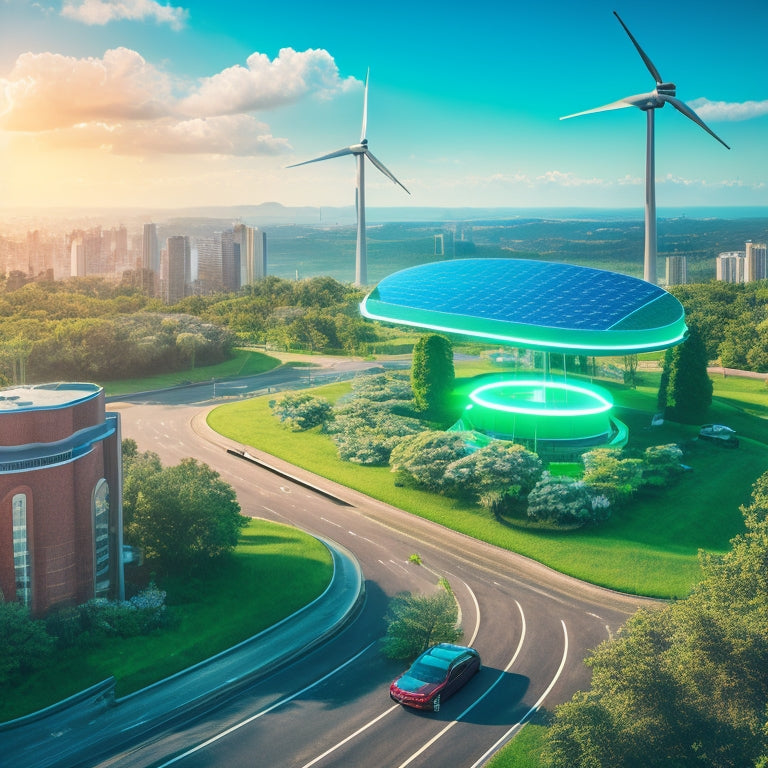
What Makes Electric Vehicle Charging Systems Go Green?
Share
You're likely to reduce your carbon footprint by up to 70% by leveraging renewable energy sources, optimizing solar panel systems, and integrating energy storage solutions. By integrating renewable energy sources, you can supply up to 30% of the energy required to charge your EV. Optimized solar panel systems can maximize energy harvesting capacity, and energy storage solutions can reduce peak demand on the grid. You'll reduce energy waste and increase efficiency by analyzing charging patterns, implementing smart charging systems, and optimizing charging station performance. As you dive deeper into the world of EV charging, you'll uncover more opportunities to create a sustainable energy future.
Key Takeaways
• Integrating renewable energy sources, like solar power, can supply up to 30% of the energy required to charge an EV.
• Optimizing solar panel system design and angular efficiency can maximize energy yield and reduce reliance on the grid.
• Implementing energy storage solutions, such as advanced battery systems, can enhance the efficiency and reliability of EV charging infrastructure.
• Smart charging systems that adjust charging rates based on energy demand can reduce strain on the grid and optimize energy distribution.
• Effective grid resiliency and load management strategies prevent brownouts, blackouts, and disruptions by managing peak demand and optimizing energy distribution.
Harnessing Renewable Energy Sources
As you explore electric vehicle charging systems, you'll find that integrating renewable energy sources is essential, and one of the most promising approaches is to harness solar power, which can supply up to 30% of the energy required to charge an EV.
This shift towards renewable energy is vital, and one of the most pressing concerns is to reduce the carbon footprint of EVs and supports the shift to a Low-Carbon Transportation System.
To achieve this, renewable infrastructure, such as solar farms and wind turbines, must be developed and integrated into the energy grid.
Energy politics play a significant role in this process, as policymakers must create incentives and regulations that support the growth of renewable energy sources.
By investing in renewable infrastructure, we can reduce our reliance on fossil fuels and create a more sustainable energy future.
In fact, studies have shown that widespread adoption of renewable energy sources could reduce greenhouse gas emissions from transportation by up to 70%.
As you explore the possibilities of electric vehicle charging systems, you'll discover that harnessing renewable energy sources is key to opening up a cleaner, greener future.
Efficient Solar Panel System Design
As you design an efficient solar panel system, you'll need to examine ideal panel angles to maximize energy yield.
By analyzing your location's latitude, altitude, and climate, you can determine the perfect angle for your panels to capture the most sunlight.
Optimal Panel Angles
Determining the ideal panel angle is essential to maximize energy yield, as a deviation of just 10 degrees from the perfect angle can result in up to 3% loss in energy production.
As you design your efficient solar panel system, you'll want to fine-tune the panel tilt to capture the most sunlight. Angular efficiency is paramount, and even a slight miscalculation can impact your energy output.
To achieve peak performance, you'll need to take into account your location's latitude, the time of year, and the surrounding environment.
A general rule of thumb is to tilt your panels at an angle equal to your latitude, but this may vary depending on your specific situation. You may need to adjust your panel angle seasonally to account for the changing sun position.
Energy Harvesting Strategies
You can substantially boost your electric vehicle charging system's energy yield by implementing a well-designed energy harvesting strategy that takes into account your solar panel system's specific configuration and local environmental conditions.
By optimizing your solar panel system's design, you can maximize energy output and reduce reliance on the grid. In urban planning, this can be achieved through building-integrated photovoltaics (BIPV) that seamlessly integrate solar panels into building facades. In rural development, decentralized solar-powered charging stations can provide energy access to remote communities.
To develop an effective energy harvesting strategy, you'll need to examine factors such as panel orientation, tilt, and tracking systems.
By analyzing your local climate and solar irradiance patterns, you can optimize your system's performance and reduce energy losses. Additionally, incorporating energy storage systems and smart grid technologies can help stabilize the grid and guarantee a reliable energy supply.
Maximizing Energy Harvesting Capacity
As you endeavor to maximize energy harvesting capacity in your electric vehicle charging system, you'll need to optimize solar power integration and energy storage.
By doing so, you can facilitate a reliable and efficient energy supply, which is critical for EV charging infrastructure.
Solar Power Integration
By integrating solar power into electric vehicle charging systems, you can capitalize on the abundance of renewable energy and maximize energy harvesting capacity.
This fusion enables you to tap into the limitless potential of solar energy, reducing reliance on fossil fuels and mitigating your carbon footprint.
As a result, you'll be contributing to a cleaner, more sustainable future.
Energy Storage Optimization
Optimizing energy storage capacity is pivotal to maximizing the energy harvesting potential of your solar-powered electric vehicle charging system, allowing you to store excess energy generated during the day for later use.
By doing so, you can guarantee a seamless and efficient charging experience.
To achieve this, you can implement advanced energy storage solutions, such as battery swapping, which enables the rapid replacement of depleted batteries with fully charged ones.
This approach not only reduces downtime but also increases the overall energy harvesting capacity of your system.
Additionally, integrating your charging system with smart grids can optimize energy distribution and consumption, guaranteeing that excess energy is stored and utilized efficiently.
Reducing Carbon Footprint Emissions
Your electric vehicle (EV) charging system can substantially reduce carbon footprint emissions by leveraging renewable energy sources and smart charging technologies.
By doing so, you can minimize your reliance on fossil fuels and lower greenhouse gas emissions.
One effective way to achieve this is by implementing carbon pricing, which puts a monetary value on carbon emissions, encouraging you to switch to cleaner energy alternatives.
Additionally, taking advantage of green incentives, such as tax credits or rebates, can offset the costs of shifting to a more sustainable charging infrastructure.
By combining these strategies, you can markedly reduce your carbon footprint and contribute to a cleaner, healthier environment.
For instance, a study by the National Renewable Energy Laboratory found that widespread adoption of EVs and renewable energy could reduce emissions by up to 70% by 2050.
Integrating Energy Storage Solutions
Implementing energy storage solutions, such as advanced battery systems, can substantially enhance the efficiency and reliability of your electric vehicle charging infrastructure.
By integrating energy storage, you can reduce peak demand on the grid, minimize strain on the electrical distribution system, and optimize energy usage.
This is particularly important when it comes to high-power charging stations, which can have significant energy densities.
By storing excess energy generated during off-peak hours, you can reduce the strain on the grid during peak hours, ensuring a more stable and efficient charging experience.
In a Smart Grid system, energy storage solutions can play a critical role in managing energy distribution and consumption.
By leveraging advanced battery technologies, you can optimize energy usage, reduce waste, and increase the overall efficiency of your electric vehicle charging infrastructure.
This not only reduces your carbon footprint but also enables you to take advantage of time-of-use pricing, reducing your energy costs.
Optimizing Charging Station Performance
By analyzing charging patterns and usage data, you can identify opportunities to fine-tune your charging station's performance, ensuring maximum efficiency and minimizing downtime. This data-driven approach enables you to optimize your station's performance, reducing energy waste and increasing user satisfaction.
To take your charging station to the next level, consider the following strategies:
-
Smart Charging: Implement smart charging systems that adjust charging rates based on energy demand, reducing strain on the grid and optimizing energy distribution.
-
Station Maintenance: Regularly inspect and maintain your charging station to prevent technical issues, ensuring continuous operation and minimizing downtime.
-
Real-time Monitoring: Utilize real-time monitoring systems to track energy usage, identify potential issues, and respond promptly to any disruptions.
-
Load Balancing: Implement load balancing techniques to distribute energy efficiently, reducing peak demand and strain on the grid.
-
Data Analytics: Leverage data analytics to identify trends, optimize charging patterns, and improve overall station performance.
Grid Resiliency and Load Management
Effective grid resiliency and load management strategies are essential to preventing brownouts, blackouts, and other disruptions that can cripple your electric vehicle charging infrastructure.
As you integrate more electric vehicles into the grid, managing peak demand becomes pivotal to maintaining a stable and efficient power supply.
That's where Smart Grids come in – advanced technologies that enable real-time monitoring and optimization of energy distribution. With Smart Grids, you can implement Peak Shaving strategies to reduce strain on the grid during peak hours. This involves shifting non-essential loads to off-peak periods or utilizing energy storage systems to absorb excess energy.
By doing so, you can reduce the likelihood of grid overloads and guarantee reliable charging for your electric vehicles.
Data-driven analysis is key to identifying areas of inefficiency and optimizing your grid resiliency strategy. By leveraging advanced analytics and IoT sensors, you can pinpoint areas of high energy demand and develop targeted solutions to mitigate them.
Frequently Asked Questions
Can Existing Electrical Grids Support Widespread EV Charging?
As you venture onto an electrified highway, you wonder: can the grid keep up? The answer lies in grid capacity and power distribution. Currently, the grid can support EV charging, but infrastructure upgrades will be necessary to accommodate widespread adoption.
How Does Weather Impact Electric Vehicle Charging Efficiency?
You'll find that weather substantially impacts electric vehicle charging efficiency, as extreme temperatures and humidity affect battery performance, with climate control systems mitigating these effects, while weather patterns like heatwaves and cold snaps influence charging speeds and energy consumption.
Are Electric Vehicle Charging Systems Compatible With All Vehicles?
"Blood is thicker than water," but when it comes to electric vehicle charging systems, compatibility is key. You'll find that most vehicles adhere to Vehicle Standards, allowing seamless integration with Level 1, Level 2, and DC Fast Chargers.
Can Electric Vehicle Charging Systems Be Installed in Residential Areas?
You can install electric vehicle charging systems in residential areas through home installations or neighborhood hubs, ensuring convenient and efficient charging solutions, with options for Level 2 or DC Fast Charging, depending on your needs.
Do Electric Vehicle Charging Systems Require Frequent Maintenance?
You'll be relieved to know that electric vehicle charging systems require minimal maintenance, with regular inspections and software updates ensuring peak performance and reducing downtime, allowing you to charge your vehicle with confidence.
Related Posts
-

5 Efficient Air Circulation Methods for Green Homes
You can utilize the power of natural ventilation techniques, whole house fans, and solar-powered ventilation systems ...
-

Transform Your Outdoor Space With Recycled Plastic Lumber
By incorporating recycled plastic lumber into your outdoor design, you're not just building a deck or installing a fe...
-

What Air Purifiers Save Energy in Work Areas?
You can cut energy costs and reduce your carbon footprint by choosing air purifiers designed with energy efficiency i...


